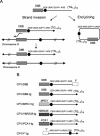RAD51-dependent break-induced replication in yeast
- PMID: 14993274
- PMCID: PMC355873
- DOI: 10.1128/MCB.24.6.2344-2351.2004
RAD51-dependent break-induced replication in yeast
Abstract
A chromosome fragmentation assay was used to measure the efficiency and genetic control of break-induced replication (BIR) in Saccharomyces cerevisiae. Formation of a chromosome fragment by de novo telomere generation at one end of the linear vector and recombination-dependent replication of 100 kb of chromosomal sequences at the other end of the vector occurred at high frequency in wild-type strains. RAD51 was required for more than 95% of BIR events involving a single-end invasion and was essential when two BIR events were required for generation of a chromosome fragment. The similar genetic requirements for BIR and gene conversion suggest a common strand invasion intermediate in these two recombinational repair processes. Mutation of RAD50 or RAD59 conferred no significant defect in BIR in either RAD51 or rad51 strains. RAD52 was shown to be essential for BIR at unique chromosomal sequences, although rare recombination events were detected between the subtelomeric Y' repeats.
Figures


References
-
- Adams, A., D. E. Gottschling, C. A. Kaiser, and T. Stearns. 1998. Methods in yeast genetics, a Cold Spring Harbor Laboratory course manual. Cold Spring Harbor Laboratory Press, Cold Spring Harbor, N.Y.
-
- Aguilera, A. 2001. Double-strand break repair: are Rad51/RecA-DNA joints barriers to DNA replication? Trends Genet. 17:318-321. - PubMed
-
- Alani, E., R. Padmore, and N. Kleckner. 1990. Analysis of wild-type and rad50 mutants of yeast suggests an intimate relationship between meiotic chromosome synapsis and recombination. Cell 61:419-436. - PubMed
-
- Bai, Y., and L. S. Symington. 1996. A Rad52 homolog is required for RAD51-independent mitotic recombination in Saccharomyces cerevisiae. Genes Dev. 10:2025-2037. - PubMed
Publication types
MeSH terms
Substances
Grants and funding
LinkOut - more resources
Full Text Sources
Other Literature Sources
Molecular Biology Databases
Research Materials
Miscellaneous
